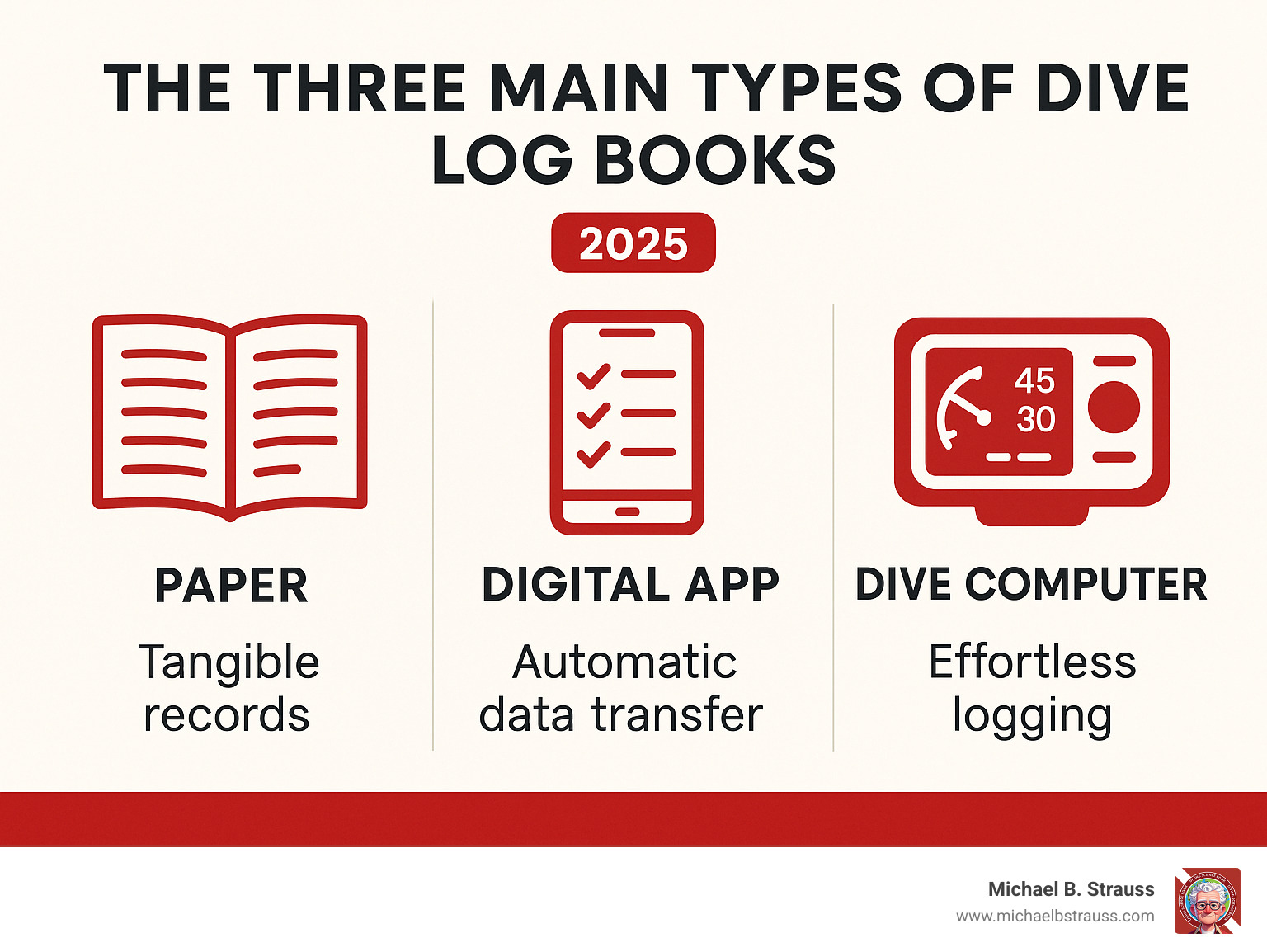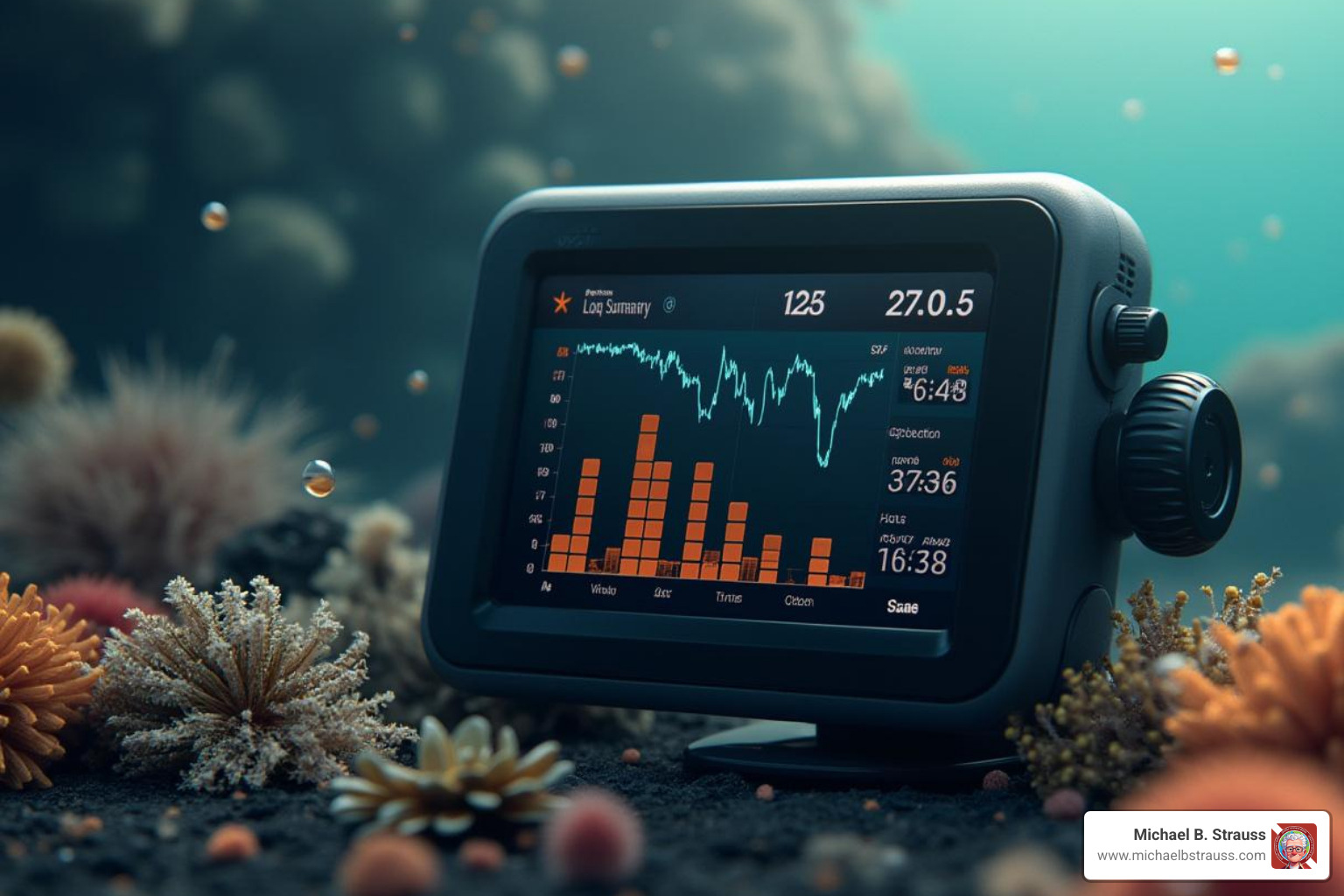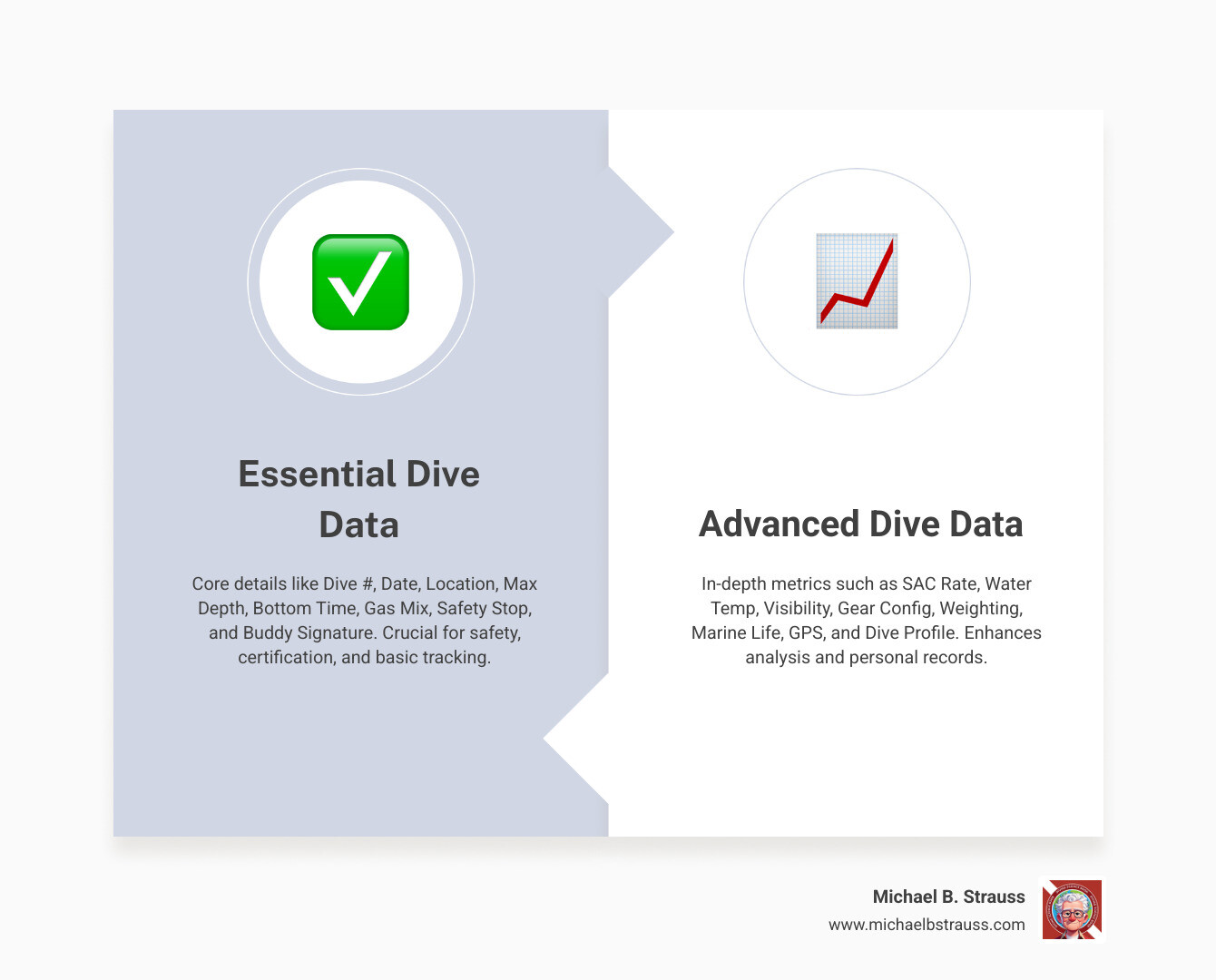Why Every Diver Needs a Log Book
Finding the best diving log book can feel like a big task. Many divers find their first logbook doesn't last. As one diver shared, their simple log was "pretty much destroyed after 25 dives, due solely to water damage." This experience is common.
So, what should you look for? The "best" log book depends on you.
Here are the main types of dive log books and a key benefit for each:
- Traditional Paper Log Books: Tangible records you can hold and get stamped.
- Digital Dive Log Apps: Automatic data transfer from your dive computer and easy sharing.
- Integrated Computer Logs: Effortless logging built right into your dive computer.
Logging your dives is more than just a habit. It's vital for every diver. A good log book serves many purposes:
- Proof of Experience: Shows your dive history for courses or charter boats.
- Memory Keeper: Helps you remember amazing moments, marine life, and dive buddies.
- Skill Tracker: Lets you review details like air consumption to improve your diving.
- Safety Tool: Helps you plan future dives by remembering past gear setups or conditions.
No matter your dive level, a log book is your personal dive journal. It helps us learn and grow with every splash.

Best diving log book vocab to learn:
Finding the Best Diving Log Book: A Comparison of Types
When searching for the best diving log book, there's no single perfect choice. The ideal option depends on your personal diving style, tracking preferences, and whether you prefer a physical record or a digital one. Let's explore the types available to see their unique advantages and disadvantages.
The Classic Choice: Traditional Paper Log Books
For many divers, a traditional paper log book has a special charm. The ritual of writing down dive details and getting an official dive center stamp creates a tangible record of your underwater journey that doesn't need batteries. The sense of nostalgia and the tactile experience are big reasons why many divers love them.
However, paper logs have challenges, primarily the risk of water damage. A splash can ruin your records, making durability and water-resistant materials incredibly important. Some manufacturers use tough, synthetic paper that resists water and tearing.
Another consideration is manual data entry, which can be time-consuming. They also offer less space for detailed notes or photos than digital options.
Despite these potential drawbacks, paper log books have evolved. You can find them in all sorts of formats, from simple booklets to binder systems that let you use refill pages. This means you can customize your log book as your diving trips continue. For those who appreciate the hands-on feel, a durable, water-resistant paper log book can still be the best diving log book choice. It’s a reliable companion that won't let you down, even when your devices run out of battery.
More info about diving medical problems
The Modern Solution: Digital Dive Log Apps

In our digital world, dive log apps are a convenient and powerful alternative. The main benefit is automation. Many apps offer automatic data transfer from your dive computer via Bluetooth sync, effortlessly logging precise depth, time, and temperature details.
Beyond basic logging, these apps offer many features. Your dive data is kept safe with cloud backup. You can add photo and video integration to create a vivid record of your trips. Most apps also allow social sharing to show off your dives.
For data-loving divers, apps provide advanced data analysis with metrics like your SAC (Surface Air Consumption) rate and oxygen toxicity levels. This data helps you become a better diver. Apps also offer gear tracking, GPS integration, and planning features. Some even have community features for finding buddies or booking trips. Major organizations like PADI let you display your digital certifications (eCards) right in the app!
While handy, digital apps have downsides. They rely on battery power, and some have subscription costs. Data security and privacy are also important considerations with online storage. Lastly, full functionality often requires an internet connection.
The Integrated Approach: Dive Computer Logs

For ultimate convenience, many modern dive computers have built-in logging. This offers effortless logging, as the computer automatically records key details like depth, time, and temperature. When you surface, the log is ready, often with an integrated dive profile graph.
Most dive computer manufacturers provide software or mobile apps to download and manage these logs. This often includes tools for analyzing your dive profiles, adjusting computer settings, and updating the computer's firmware (its internal software). It's a good idea to keep your computer updated for the latest features.
However, these systems can have limitations. Data export can sometimes be restricted, and they typically offer less space for personal notes or observations. You might still find yourself wanting a separate system for those more personal touches.
The best diving log book for you might actually be a combination of these approaches! You could use your dive computer for the raw data, a digital app for analysis and sharing, and perhaps even a small, waterproof paper log for quick notes or to capture those truly special dives.
More info about decompression science
Essential Features for Any Great Dive Log
No matter which format you pick, certain information is essential for any good dive log. These details help track your progress and are critical for safety and future dive planning.

Let's break down what to log:
Essential Data:
- Dive #: Your personal count. PADI defines an "open water dive" as one at 5m/15ft or deeper, using at least 1400L/50cu ft of gas, or lasting 20+ minutes.
- Date: Keeps your dives in order.
- Location & Dive Site: Remember where you've been.
- Max Depth & Bottom Time: The deepest point and total time underwater.
- Gas Mix (Air/Nitrox): Crucial for safety, especially with enriched air (EANx). Note the EANx% and gas analysis results.
- Time In/Out: Start and end times.
- Air In/Out: Starting and ending tank pressure helps track air consumption. Aim to end with 50 bar/700 psi.
- Safety Stop: A checkmark to confirm completion.
- Buddy Signature: Confirmation from your dive partner.
- Instructor/Divemaster Signature & Dive Centre Stamp: Vital for training and proof of experience.
Advanced Data:
- SAC Rate (Surface Air Consumption): Measures air efficiency.
- Water Temp: Helps choose future thermal protection.
- Visibility: A subjective measure of water clarity.
- Current & Waves: Notes on conditions to expect.
- Gear Configuration: Recall what wetsuit, BCD, or tank worked best.
- Weighting & Buoyancy Assessment: Fine-tune your weight for perfect trim.
- Marine Life Sightings: Log the creatures you encountered.
- GPS Coordinates: For precise mapping.
- Dive Profile Graph: A visual of your depth over time, often automatic.
- Comments/Notes: A space for personal observations, making the log your own.
Reviewing log data helps you learn from every dive. The data doesn't lie, helping you understand your habits, improve skills, and ensure safer dives.
What to Log: A Guide for New and Advanced Divers
Why we log dives changes with experience. For new divers, logging is a certification requirement. Each training dive must be documented and signed by an instructor, creating a verifiable record for future advanced courses.
As we become more experienced, logging becomes an incredibly valuable tool for self-improvement and simply enjoying our dives more.
- Tracking Air Consumption: Regularly noting your starting and ending air pressures helps you track your air consumption rate over time. This shows if you're becoming more efficient, which means longer bottom times and better gas management.
- Documenting Gear for Future Dives: You can use your log to record details like the type of wetsuit you wore, the water temperature, and how much weight you used. This information is like gold for planning future dives in similar conditions, making sure you’re always perfectly weighted and comfortable. It's also useful for tracking gear maintenance, like "first dive with new reg."
- Noting Conditions: While subjective, recording visibility, current, and wave conditions helps you build a mental database of how different dive sites behave under various circumstances. This helps you choose the right dive site and manage your expectations.
- Personal Dive Journal: Beyond the numbers, your log book is a place for personal reflection. You can jot down memorable encounters, funny stories, challenges you overcame, or even draw a quick sketch of a unique coral formation. This is where your log transforms from just a data sheet into a cherished journal of your underwater life.
- Safety Analysis: Reviewing your logs can help you spot patterns in your diving. For example, consistently fast ascent rates might highlight an area where you can improve. Dr. Michael B. Strauss, a well-known expert in diving safety, stresses that understanding your dive data is key to safe diving. Your log becomes a tool for continuous self-assessment and improvement, helping you make smarter decisions for your next underwater trip.
Whether you're carefully tracking every metric for professional growth or just jotting down a "Saw a turtle!" moment, the act of logging enriches your diving experience and helps you grow as a diver.
More info about diving science
Conclusion: The Right Log for Your Underwater Trips
So, what's the best diving log book for you? The best one is the one you'll use consistently. It's a personal choice, balancing feel, convenience, and what you prefer for your diving trips.
We've covered traditional paper logs for those who love a tangible record, modern digital apps with easy transfers and photo sharing, and the seamless logging of a dive computer.
No matter which type you choose, the reason for logging remains the same. Essential details like depth, time, and gas use are tools to preserve memories, improve skills, and boost safety. Reviewing your dive history helps you learn from your performance, a practice that aligns with the teachings of experts like Dr. Michael B. Strauss on safe diving.
Think about your diving style and what you need. Do you want a waterproof log, detailed data analysis, or a simple way to remember your trips? The choice is yours. Whatever you pick, your log book will be a valuable companion on every future dive, helping you grow and enjoy the underwater world even more.
DISCLAIMER: Articles are for "EDUCATIONAL PURPOSES ONLY", not to be considered advice or recommendations.
To learn more about the science behind safe diving practices, get your copy of Diving Science, Revisited today: https://www.bestpub.com/view-all-products/product/diving-science-revisited/category_pathway-48.html







